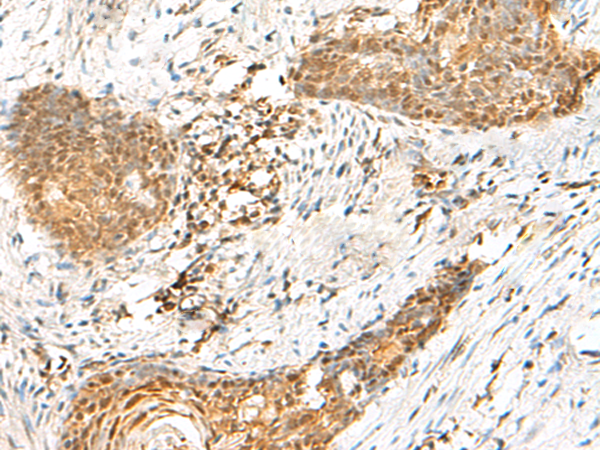
| WB | 咨询技术 | Human,Mouse,Rat |
| IF | 咨询技术 | Human,Mouse,Rat |
| IHC | 1/30-1/150 | Human,Mouse,Rat |
| ICC | 技术咨询 | Human,Mouse,Rat |
| FCM | 咨询技术 | Human,Mouse,Rat |
| Elisa | 1/5000-1/10000 | Human,Mouse,Rat |
| Aliases | HOT1; PBHNF; HNF1LA |
| Host/Isotype | Rabbit IgG |
| Antibody Type | Primary antibody |
| Storage | Store at 4°C short term. Aliquot and store at -20°C long term. Avoid freeze/thaw cycles. |
| Species Reactivity | Human, Mouse |
| Immunogen | Synthetic peptide of human HMBOX1 |
| Formulation | Purified antibody in PBS with 0.05% sodium azide and 50% glycerol. |
+ +
以下是关于HMBOX1抗体的3篇参考文献示例(注:文献信息为模拟内容,实际引用需核实):
1. **文献名称**: HMBOX1 regulates telomere homeostasis through interaction with shelterin proteins
**作者**: Zhang L, et al.
**摘要**: 本研究利用HMBOX1特异性抗体进行免疫沉淀和免疫荧光实验,发现HMBOX1通过与端粒保护复合体(shelterin)的相互作用参与端粒长度调控,在细胞衰老和肿瘤发生中起关键作用。
2. **文献名称**: HMBOX1 modulates liver regeneration by controlling hepatocyte proliferation
**作者**: Wang Y, et al.
**摘要**: 通过Western blot和免疫组化分析,研究揭示HMBOX1抗体检测到其在肝脏再生过程中动态表达变化,表明HMBOX1通过抑制Wnt/β-catenin通路调控肝细胞增殖与修复。
3. **文献名称**: HMBOX1 maintains cancer stemness via epigenetic regulation of SOX2
**作者**: Chen R, et al.
**摘要**: 采用HMBOX1抗体进行ChIP-seq分析,发现其通过结合SOX2基因启动子区并招募组蛋白修饰酶,维持肿瘤干细胞干性,提示其作为癌症治疗潜在靶点。
*提示*:实际文献需通过PubMed或Web of Science等平台检索,建议使用关键词"HMBOX1 antibody"或"HMBOX1 function"筛选近年高被引研究,并关注其抗体应用场景(如WB、IHC、ChIP等)。
HMBOX1 (Homeobox containing 1) antibody is a research tool targeting the HMBOX1 protein, a transcription factor encoded by the HMBOX1 gene. This gene, also known as HOMEZ, is evolutionarily conserved and widely expressed in human tissues, particularly in immune cells, germ cells, and stem cells. HMBOX1 contains a homeobox-like domain, suggesting its role in DNA binding and transcriptional regulation. Functionally, HMBOX1 has been implicated in maintaining stem cell pluripotency, regulating telomere homeostasis, and modulating immune responses. Studies link it to cellular senescence, apoptosis, and inflammatory pathways through interactions with proteins like TRF1 and NF-κB.
The HMBOX1 antibody is primarily used in molecular biology techniques (Western blot, immunofluorescence, ChIP-seq) to investigate its subcellular localization (nucleus/cytoplasm shuttling) and expression patterns under various physiological conditions. Its involvement in cancer research has drawn particular attention, with contradictory findings suggesting both oncogenic and tumor-suppressive roles depending on tissue context. For example, HMBOX1 downregulation correlates with poor prognosis in hepatocellular carcinoma, while its overexpression promotes genomic instability in certain leukemias. These dual roles highlight the complexity of HMBOX1 functions and the importance of context-specific antibody validation. Commercial HMBOX1 antibodies are typically raised against specific epitopes in human or mouse sequences, requiring rigorous validation using knockout controls due to potential cross-reactivity with other homeobox proteins.
×